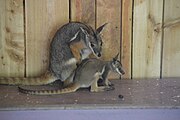Yellow-footed rock-wallaby
| Yellow-footed rock-wallaby[1] | |
|---|---|

| |
| Scientific classification | |
| Kingdom: | |
| Phylum: | |
| Class: | |
| Subclass: | |
| Order: | |
| Family: | |
| Genus: | |
| Species: | P. xanthopus
|
| Binomial name | |
| Petrogale xanthopus Gray, 1855
| |

| |
| Distribution of the yellow-footed rock-wallaby | |
The Yellow-footed rock-wallaby (Petrogale xanthopus), formerly known as the ring-tailed wallaby, is a member of the macropod family (the marsupial family that includes the kangaroos, wallabies, tree-kangaroos, and wallaroos).
Description
The yellow-footed rock wallaby is regarded to be one of the handsomest marsupials and was once killed in large numbers for its pelt. The pelage is grey-brown with a yellow tail banded with dark rust colored stripes, white underside, yellow forearms and yellow feet. A fully grown adult will stand 60 cm (23.6 in) high and weighs 7–13 kg (15.4–28.7 lb).
Distribution and habitat
This species of rock-wallaby is found in western New South Wales, northwestern Victoria, eastern South Australia and isolated portions of Queensland. It is not typically found near human habitation, instead preferring rough terrain and rock outcroppings. Rock wallabies scale cliffs and climb rocks with superb agility and can leap sizable chasms. Because their habitat is relatively inaccessible to grazing animals, rock wallabies have generally fared better than other small members of the kangaroo family.
Subspecies
At least one subspecies of this nocturnal diprotodont (P. x. xanthopus) appears on the IUCN Red List of Threatened Species as vulnerable.[3] The subspecies has a population of only about 5,000–10,000 in Queensland, is present in small numbers in the Flinders Ranges of South Australia and known from only the Gap and Cotraundee Ranges in New South Wales.
The other subspecies (P. x. celeris) is listed at near threatened.[4] This species prefers rock crevices and caves in isolated rock outcrops and ridges in semi-arid country. It is threatened by fox predation, competition with domestic and wild introduced species (particularly goats, rabbits, and sheep), and bushfires.
Conservation
In New South Wales the yellow-footed rock-wallaby was first recorded in 1964 in the Coturaundee Ranges, now part of Mutawintji National Park. The two small mountain ranges in the far west of the state are still the only known places where the species survives in New South Wales.
The habitat of the surviving population is partly on private land, granting inadequate protection for the colonies. Scientists were certain that without immediate action the yellow-footed rock-wallaby would become extinct in New South Wales.
In 1979, the Foundation for National Parks & Wildlife purchased 100 square kilometres of this land, which then became Coturaundee Nature Reserve, for the conservation and protection of the yellow-footed rock-wallaby. Further funds were allocated to fox and goat eradication.
Annual surveys of the area, which is now part of Mutawintji National Park, confirm that the population is now recovering, having grown every year since 1995. There are now between 300 and 400 wallabies.
The recovery strategy that saved the yellow-footed rock-wallaby now serves as a model to preserve other rock-wallabies including the brush-tailed rock-wallaby from extinction.
References
- ^ Groves, C. P. (2005). Wilson, D. E.; Reeder, D. M. (eds.). Mammal Species of the World: A Taxonomic and Geographic Reference (3rd ed.). Baltimore: Johns Hopkins University Press. p. 69. ISBN 0-801-88221-4. OCLC 62265494.
- ^ Template:IUCN2008 Database entry includes justification for why this species is listed as near threatened
- ^ Template:IUCN2006
- ^ Template:IUCN2006
Gallery
-
Yellow-footed rock-wallaby with joey, Adelaide Zoo
-
A yellow-footed rock-wallaby in the wild at Warren gorge in the Flinders Ranges
-
Female rock wallaby with young just out of pouch, Bristol Zoo




